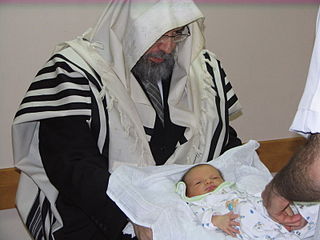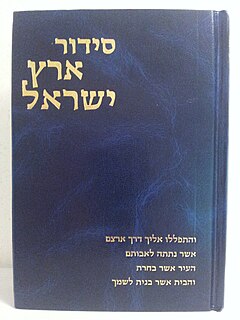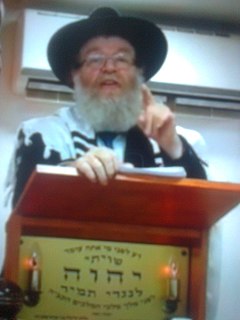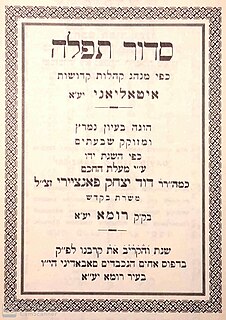Related Research Articles

Jewish prayer is the prayer recitation that forms part of the observance of Rabbinic Judaism. These prayers, often with instructions and commentary, are found in the Siddur, the traditional Jewish prayer book.

A siddur is a Jewish prayer book containing a set order of daily prayers. The word siddur comes from the Hebrew root ס־ד־ר, meaning 'order.'

Selichot are Jewish penitential poems and prayers, especially those said in the period leading up to the High Holidays, and on fast days. The Thirteen Attributes of Mercy are a central theme throughout these prayers.
A Yekke is a Jew of German-speaking origin. The term carries the connotation that German Jews are notable for attention to detail and punctuality.
Minhag is an accepted tradition or group of traditions in Judaism. A related concept, Nusach, refers to the traditional order and form of the prayers.
In Judaism, Nusach, plural nuschaot or Modern Hebrew nusachim, refers to the exact text of a prayer service; sometimes the English word "rite" is used to refer to the same thing. Texts used by different communities include Nosach Teiman, Nusach Ashkenaz, Nusach Sefard, Nusach Edot Hamizrach, and Nusach Ari. In English, the word nusach means formulate, wording.
Dushinsky is one of the few Hasidic dynasties not named after the place where it originated; instead, it is named after the surname of the Rebbe. It is a relatively new dynasty, as are many of the dynasties that originated in Hungary. However, the Dushinsky dynasty truly became a dynasty in Jerusalem, where it is centered today. It is not like other Hasidic groups, in that it does not originate from a Hasidic background, but from the talmidim (students) of the Chasam Sofer.
Mussaf is an additional service that is recited on Shabbat, Yom Tov, Chol Hamoed, and Rosh Chodesh. The service, which is traditionally combined with the Shacharit in synagogues, is considered to be additional to the regular services of Shacharit, Mincha, and Maariv. In contemporary Hebrew, the word may also signify a newspaper supplement.

Sadigura is a Hasidic dynasty named for the city of Sadhora, Bukovina, which belonged to Austria. The dynasty began in 1850 with Rabbi Avrohom Yaakov Friedman, a son of Rabbi Yisrael Friedman of Ruzhyn, and was based in Sadigura until 1914. During the interwar period the dynasty was led by Rebbes in Vienna and Przemyśl, Poland, and on the eve of World War II was transplanted to Israel, where it thrives to this day.

Khal Adath Jeshurun (KAJ) is an Orthodox German Jewish Ashkenazi congregation in the Washington Heights neighborhood, in the New York City borough of Manhattan. It has an affiliated synagogue in the heavily Orthodox Jewish neighborhood of Monsey, New York.

Yaacov Haber is a rabbi has taught Jews about Jewish heritage for almost thirty years.
Nusach Sefard, Nusach Sepharad, or Nusach Sfard is the name for various forms of the Jewish siddurim, designed to reconcile Ashkenazi customs with the kabbalistic customs of Isaac Luria. To this end it has incorporated the wording of Nusach Edot haMizrach, the prayer book of Sephardi Jews, into certain prayers. Nusach Sefard is used nearly universally by Hasidim, as well as by some other Ashkenazi Jews but has not gained significant acceptance by Sephardi Jews. Some Hasidic dynasties use their own version of the Nusach Sefard siddur, sometimes with notable divergence between different versions.
Vien is an American Haredi Kehilla (community) originating in present-day Vienna. The name of their congregation is "Kehal Adas Yereim Vien".
Nusach Ashkenaz is a style of Jewish liturgy conducted by Ashkenazi Jews. It is primarily a way to order and include prayers, and differs from Nusach Sefard and Baladi-rite prayer, and still more from the Sephardic rite proper, in the placement and presence of certain prayers.
Baruch Adonai L'Olam is a prayer that is recited by some Jewish communities, during Maariv on weekdays immediately preceding the Amidah. It contains a tapestry of 18 biblical verses, followed by a blessing titled Yiru Eineinu.

The Palestinian minhag or Palestinian liturgy, as opposed to the Babylonian minhag, refers to the rite and ritual of medieval Palestinian Jewry in relation to the traditional order and form of the prayers.

Binyamin Shlomo Hamburger is a rabbi and author who is regarded as an expert on the subject of minhag Ashkenaz, the customs of German and Western European Jews, and their history. Born in Basel, Switzerland, to German parents, he currently lives in Bnei Brak, Israel.
Minhag Morocco refers to the religious customs adopted by Moroccan Jewry, from the Hebrew "Minhag", or custom. Although in the Middle Ages, there was a unique Nusach Morocco, unrelated to Sephardic liturgy, this original minhag has not be practiced since shortly after the Expulsion of Jews from Spain, and it is unfortunately not well documented. Since this time, the Moroccan rite has been a subset of the Sephardic rite, but with certain customs of its own. Many sources contributed to and influenced the development of Moroccan religious customs, including the Shulchan Aruch, the Livorno minhag, the Ashkenazic minhag and even the presence of the Chabad-Lubavitch movement in Morocco. Minhag Morocco can be considered a sub-class within the Sephardic minhag but has many differences and unique traits. A related concept that falls under Minhag Morocco is the Moroccan Nusach, which more specifically refers to the variations in the prayer service.
Minhag Polin/Minhag Lita is the Ashkenazi minhag of the Polish Jews, the Polish/Lithuanian or Eastern branch of Nusach Ashkenaz, used in Eastern Europe, the United States and by some Israeli Ashkenazim, particularly those who identify as "Lithuanian". This is different from German or Western branch of Nusach Ashkenaz, known in Hebrew as "Minhag Ashkenaz", used in Western and Central Europe.

Italian Nusach, also known as Minhag Italiani, Minhag B'nei Romì, Minhag Lo'ez or Minhag HaLo'azim, is the ancient prayer rite of the indigenous Jews on the Italian peninsula who are not of Ashkenazi or Sephardic origin.
References
- ↑ Daniel Goldschimdt, Rosh Hashanah Machzor, page 14 of introduction. In the Middle Ages, the border seems to have been further east.
- ↑ "Bayers and Polanders, "German Jews" and "Polish Jews"". Brandeis University . Retrieved 2022-09-06.
- ↑ Lowenstein, Steven M. (1989). Frankfurt on the Hudson: The German-Jewish Community of Washington Heights, 1933–1983, Its structure and Culture. Wayne State University Press. ISBN 978-0814323854.
- ↑ "Nusach" . Retrieved 2022-09-06.
- ↑ "Communities". Machon Moreshes Ashkenaz. Retrieved 2022-06-07.